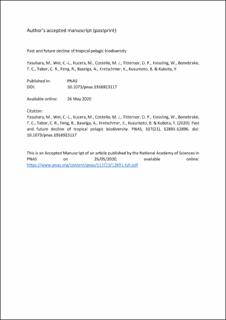Past and future decline of tropical pelagic biodiversity
Yasuhara, Moriaki; Wei, Chih-Lin; Kucera, Michal; Costello, Mark John; Tittensor, Derek P.; Kiessling, Wolfgang; Bonebrake, Timothy C.; Tabor, Clay; Feng, Ran; Baselga, Andrés; Kretschmer, Kerstin; Kusumoto, Buntarou; Kubota, Yasuhiro
Peer reviewed, Journal article
Accepted version
Permanent lenke
https://hdl.handle.net/11250/2723688Utgivelsesdato
2020Metadata
Vis full innførselSamlinger
Originalversjon
Yasuhara, M., Wei, C.-L., Kucera, M., Costello, M. J., Tittensor, D. P., Kiessling, W., Bonebrake, T. C., Tabor, C. R., Feng, R., Baselga, A., Kretschmer, K., Kusumoto, B. & Kubota, Y. (2020). Past and future decline of tropical pelagic biodiversity. Proceedings of the National Academy of Sciences of the United States of America, 117(23), 12891-12896. doi: 10.1073/pnas.1916923117Sammendrag
A major research question concerning global pelagic biodiversity remains unanswered: when did the apparent tropical biodiversity depression (i.e., bimodality of latitudinal diversity gradient [LDG]) begin? The bimodal LDG may be a consequence of recent ocean warming or of deep-time evolutionary speciation and extinction processes. Using rich fossil datasets of planktonic foraminifers, we show here that a unimodal (or only weakly bimodal) diversity gradient, with a plateau in the tropics, occurred during the last ice age and has since then developed into a bimodal gradient through species distribution shifts driven by postglacial ocean warming. The bimodal LDG likely emerged before the Anthropocene and industrialization, and perhaps ∼15,000 y ago, indicating a strong environmental control of tropical diversity even before the start of anthropogenic warming. However, our model projections suggest that future anthropogenic warming further diminishes tropical pelagic diversity to a level not seen in millions of years.
